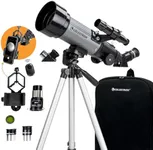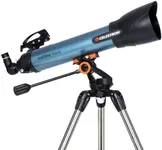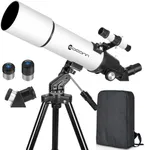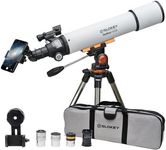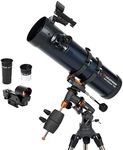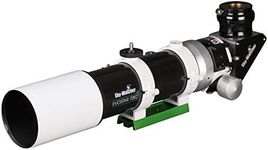Buying Guide for the Best Beginners Telescopes
Choosing a beginner telescope can be an exciting journey into the world of astronomy. The right telescope will open up the night sky and allow you to explore celestial objects like the moon, planets, and stars. When selecting a telescope, it's important to consider factors such as ease of use, portability, and the type of celestial objects you are most interested in observing. Understanding the key specifications will help you make an informed decision and find a telescope that suits your needs and interests.ApertureAperture refers to the diameter of the telescope's main optical component, which can be a lens or a mirror. It is crucial because it determines how much light the telescope can gather, affecting the brightness and clarity of the images you see. Aperture sizes can range from small (around 70mm) to large (over 200mm). For beginners, a telescope with an aperture between 70mm and 100mm is often recommended as it provides a good balance between portability and performance, allowing you to see planets and some deep-sky objects. If you're interested in viewing faint objects like distant galaxies, a larger aperture might be more suitable.
Focal LengthFocal length is the distance between the telescope's lens or mirror and the point where it forms an image. It affects the magnification and field of view of the telescope. A longer focal length provides higher magnification, which is great for observing planets and the moon, while a shorter focal length offers a wider field of view, ideal for star clusters and larger celestial objects. Beginners might prefer a telescope with a moderate focal length (around 500mm to 1000mm) to enjoy a variety of observations without overly complex setups.
Mount TypeThe mount is the structure that holds the telescope and allows it to move. It is important because it affects the stability and ease of use of the telescope. There are two main types: altazimuth and equatorial. Altazimuth mounts are simple and intuitive, moving up-down and left-right, making them ideal for beginners who want straightforward operation. Equatorial mounts are more complex and are designed to track celestial objects as they move across the sky, which is useful for more advanced observations and astrophotography. For beginners, an altazimuth mount is often recommended for its simplicity.
PortabilityPortability refers to how easy it is to transport and set up the telescope. This is important for beginners who may want to take their telescope to different locations for better viewing conditions. Smaller telescopes are generally more portable and easier to handle, making them ideal for casual stargazing and travel. If you plan to observe from various locations or have limited storage space, consider a compact and lightweight telescope that can be easily carried and set up.
Optical DesignOptical design refers to the type of optical system used in the telescope, such as refractor, reflector, or compound. Each design has its advantages and disadvantages. Refractors are known for their ease of use and low maintenance, making them great for beginners interested in observing planets and the moon. Reflectors offer larger apertures at lower costs, ideal for viewing faint deep-sky objects. Compound telescopes combine features of both refractors and reflectors, providing versatility. Beginners might choose a refractor for simplicity or a reflector for more advanced observations.
